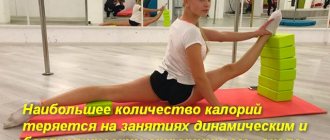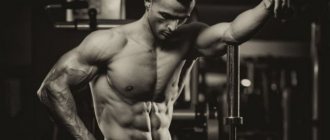Bicycle and exercise bike as a way to burn calories
Bicycle loads are considered one of the most effective and accessible for humans. On the one hand, a walk in the fresh air on a bicycle is a pleasant pastime, on the other hand, it is real action aimed at significantly improving the condition of the body, spending extra calories and losing excess weight. Exercising on a bicycle or exercise bike helps not only normalize weight, but also strengthen the heart, work out muscles and activate joints.
FACT! Scientists call weight loss a side effect of cycling, which is so pronounced that it has made this form of exercise extremely popular.
Experts identify several factors that have a direct impact on the number of calories consumed during exercise:
- Pulse . The higher the heart rate, the harder the body works and, therefore, the more calories it burns. That is why for real weight loss, not any physical exercise is effective, but only those that cause an increase in heart rate.
- Breathing . During intense exercise, muscles are saturated with oxygen, which provokes energy consumption through the breakdown of fats - which is why an increase in breathing rate is evidence of correct and effective exercise.
- Level of training and characteristics of the body. Of course, an athletic person does not require much fuel to burn calories, while people without experience need more active fuel. In addition, other characteristics of the body (for example, weight) also influence the level of energy loss.
- Features of the training . Experts recommend choosing the intensity and duration of cycling training in such a way as to create the maximum effect on calorie expenditure.
Can exercise equipment harm your health?
The answer is yes, if the classes are unsystematic, too complex programs are chosen, which is accompanied by frequent overloads. After purchasing a simulator and intensive training on it for 2-3 weeks, enthusiasm usually disappears. This is explained by muscle fatigue and body protest. In this case, training “through force” leads to a persistent aversion to exercise, and the exercise machine turns into unnecessary furniture that takes up space in the apartment.
Classes are contraindicated for hypertensive patients suffering from asthma and angina pectoris, diseases of the osteoarticular system, tachycardia, heart defects, influenza, colds and infectious diseases.
Energy consumption, i.e. The calories burned in an exercise bike and a bicycle are determined by a number of factors:
- heart rate, pulse. The higher the pulse, the more calories you burn on an exercise bike and the more calories you burn on a bike. Therefore, for getting rid of excess weight, training that causes an increase in heart rate and breathing is most suitable;
- breathing is the same as pulse. This is the other side of the same coin. Intense training leads to the enrichment of muscles with oxygen, which requires additional energy, i.e. the calorie consumption on the exercise bike and the calorie consumption on the bike increases;
- fitness. In trained people, the body does not need a lot of “fuel”, unlike inexperienced people who need active replenishment;
- weight. Here, too, everything is clear: moving them also requires energy, the amount of which is directly proportional to the mass: the legs of thin people move more easily than heavy ones;
- features of training organization. The duration of classes and intensity must be selected so that the maximum number of calories in the exercise bike and calories in the bike are consumed, i.e. there were all the conditions for this.
How many calories does cycling burn?
It is difficult for a person ignorant of the intricacies of calorie counting to understand the need to account for every calorie consumed and expended. it is extremely important for a person who is losing weight or simply watching their shape exactly how many calories were spent as a result of a particular activity. Of course, it is extremely difficult to calculate this indicator with absolute accuracy, which is why all tables give average and often different values.
- Is it possible to lose weight using an exercise bike? To know…
- Only with the right approach, exercise on an exercise bike can turn from a pointless waste of time into effective training.
- The best exercise bikes for weight loss and reviews about them.
Calorie consumption while riding a bicycle or an exercise bike depends not only on the intensity of riding, but also on the person’s weight. The averages for a 50kg cyclist are as follows:
- At a slow speed (about 9-15 km/h) 150-230 calories are consumed.
- At average speed (15-19 km/h) about 240-350 calories are spent.
- Active driving at speeds up to 25 km/h allows you to burn about 500 calories.
- Sports driving (at least 35 km/h) consumes the maximum number of calories – up to 700.
FACT! The shorter a person is, the more energy they expend on a bicycle. Therefore, tall people are advised to pedal more often to achieve the desired result.
The higher the cyclist's weight, the higher the calorie consumption: on average, you can add 150-200 calories per hour. In addition, the number of calories burned is affected by the intensity of the workout, changes in speed (so-called “interval riding”), as well as the presence or absence of weights on the exercise bike. If you choose a bicycle rather than a simulator for training, then you should additionally take into account the condition of the route, its complexity, road surface, and the slope of the road.
Advantages of cycling over other types of cardio equipment
Cardio equipment
help you lose weight by expending huge amounts of calories as a result of intense exercise, as well as improve system function and increase endurance. Unlike a treadmill, orbitrek and other types of cardio equipment, an exercise bike has virtually no contraindications, and only in some cases does a doctor’s consultation be required
To train on it you do not need to buy additional equipment (for example, for training on a treadmill
you need special sneakers to reduce the load on the spine). An exercise bike can be purchased and installed at home. There are compact models that require a minimum of space (for example, to install the same treadmill, even the simplest one, an area of at least 1.5 × 1 m is required).
The right approach to spending energy on an exercise bike
In order for cycling or exercise on an exercise bike to be as effective and efficient as possible, you should follow the recommendations of experts regarding the timing, duration and quality of the exercises:
- A beginner should start riding with short sessions, no more than 20 minutes at an easy or medium pace.
- The effectiveness of the classes will be noticeable when at least 3-4 full-fledged training sessions are completed per week.
- To lose weight, you will need a daily hour-long load at an average and active riding pace.
- Interval skating is the best option for effective exercise. They should be carried out according to this scheme: 30-60 seconds in an active rhythm, then 1-2 minutes in a calm one, and repeat in a circle.
Exercises on a bicycle and an exercise bike, including a mini exercise bike, are considered one of the most effective cardio exercises aimed at burning calories. In addition to the positive effect of maintaining body tone and losing excess weight, such activities improve mood and well-being.
How to speed up the fat burning process?
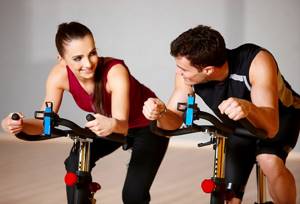
Experienced athletes, as well as weight loss experts, know five key secrets that help speed up the fat burning process by 2-3 times.
These secrets include:
Maintaining interval training. Each person should alternate the speed of the exercise.
In particular, a person losing weight is required to:
- pedal the exercise bike as intensely as possible for 25 seconds;
- for the next 45 seconds, pedal at a moderate pace;
- then switch to intense torsion again.
This interval maintenance ensures faster fat burning. For example, a 20-minute workout in this mode is equivalent to forty minutes of pedaling at the same rhythm.
Don't forget about water.
Throughout the day, each person should monitor the amount of water he drinks.
It is considered optimal to drink two liters of water per day, and it should be:
Don't eat before training.
Pedaling an exercise bike after a hearty lunch or dinner is contraindicated. When consuming food, calories enter the body, therefore, during exercise, only they will leave, while excess fats will remain in the wrong places. According to nutritionists and experts, it is ideal when someone losing weight exercises on an exercise bike:
- 40 minutes after waking up;
The optimal time for pedaling is from 7 to 11 am.
- in a great mood;
- after drinking a glass of water.
It is allowed to put 1-2 slices of lemon in a glass of water.
Monitor your diet every day.
Ideally, the diet should be designed in such a way that a person consumes the required amount daily:
- fiber;
- fats;
- carbohydrates;
- vitamins and other things.
Lead an active lifestyle, in particular:
- walk every day for 1 – 1.5 hours;
- sleep 7 – 8 hours a day;
- do not overwork;
- do not be nervous.
Take the traffic rules knowledge test for a cyclist!
Time limit: 0
Navigation (job numbers only)
0 out of 15 tasks completed
Questions:
- 1
- 2
- 3
- 4
- 5
- 6
- 7
- 8
- 9
- 10
- 11
- 12
- 13
- 14
- 15
Information
To be able to obtain rights, please click Next
You have already taken the test before. You can't start it again.
The test is loading...
You must log in or register in order to begin the test.
You must complete the following tests to start this one:
results
Correct answers: 0 out of 15
Your time:
Time is over
You scored 0 out of 0 points (0)
Categories
- No category 0%
- Please write in the comments if you liked the test.
Should things like this be added to the site? What would you like to see on the site? Thanks in advance for your feedback!
maximum of 15 points
| Place | Name | Recorded | Points | Result |
| Table is loading | ||||
| No data | ||||
Your result has been recorded in the leaderboard Loading
- 1
- 2
- 3
- 4
- 5
- 6
- 7
- 8
- 9
- 10
- 11
- 12
- 13
- 14
- 15
- With answer
- With a viewing mark
- Task 1 of 15
1.
How to exercise on an exercise bike to lose calories?
No person will be able to lose calories if he exercises the exercise bike incorrectly.
In this matter, the main thing is to adhere to the following rules:
- Pedal only in comfortable clothes and shoes.
It is optimal when a person is wearing shorts, a T-shirt, and comfortable sneakers or sneakers.
- Exercise on the simulator 3 – 4 times a week.
Before training on an exercise bike, set the desired mode, which is selected taking into account:
- physical training of someone losing weight;
- his body weight;
- the required amount of energy consumption.
- Drink 250 milliliters of clean water 20 minutes before starting exercise.
- Do a little warm-up.
Trainers and nutritionists recommend doing the following for 5 minutes before sitting on the exercise machine:
- shallow squats;
- jumping in place;
- bending to the sides;
- rotation of the body.
Such simple exercises will allow a person to tune in to the main activity, and most importantly, it will be easier to endure the intense rhythm of pedaling.
- Sit on the seat of the exercise bike, press “start” and begin pedaling intensely.
- Switch to moderate mode, and then back to intense.
- Turn off the exercise bike.
- Get up and stand quietly for 30 - 40 minutes to allow your breathing and pulse to normalize.
Are the Rules broken in the situations depicted?

Correct 6. Requirements for cyclists
6.6. A cyclist is prohibited from:
d) while driving, hold on to another vehicle;
f) tow bicycles;
Wrong 6. Requirements for cyclists
6.6. A cyclist is prohibited from:
d) while driving, hold on to another vehicle;
f) tow bicycles;
2.
Which cyclist doesn't break the rules?

Correct 6. Requirements for cyclists
6.6. A cyclist is prohibited from:
b) move on highways and roads for cars, as well as on the roadway if there is a bicycle path nearby;
Wrong 6. Requirements for cyclists
6.6. A cyclist is prohibited from:
b) move on highways and roads for cars, as well as on the roadway if there is a bicycle path nearby;
3.
Who should give way?

Correct 6. Requirements for cyclists
6.5. If a bicycle lane crosses a road outside an intersection, cyclists must give way to other vehicles traveling on the road.
Wrong 6. Requirements for cyclists
6.5. If a bicycle lane crosses a road outside an intersection, cyclists must give way to other vehicles traveling on the road.
4.
What loads is a cyclist allowed to carry?

Correct 6. Requirements for cyclists
6.4. A cyclist may only carry such loads that do not interfere with the operation of the bicycle and do not create obstacles for other road users.
22. Cargo transportation
22.3. Transportation of cargo is permitted provided that it:
b) does not interfere with the stability of the vehicle and does not complicate its control;
Wrong 6. Requirements for cyclists
6.4. A cyclist may only carry such loads that do not interfere with the operation of the bicycle and do not create obstacles for other road users.
22. Cargo transportation
22.3. Transportation of cargo is permitted provided that it:
b) does not interfere with the stability of the vehicle and does not complicate its control;
5.
Reviews
By following the recommendations and regular exercise, many manage to lose about 3-4 kilograms in a month. Exercises effectively help tighten, pump up your legs, and get rid of cellulite. However, there are reviews about the absence of any results even after a month of training, which may be due to both the individual characteristics of the body and non-compliance with certain rules.
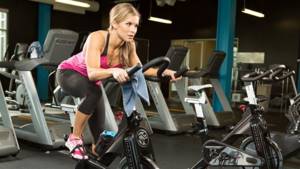
Which cyclists violate the Rules when transporting passengers?

Correct 6. Requirements for cyclists
6.6. A cyclist is prohibited from:
e) carry passengers on a bicycle (except for children under 7 years old, transported on an additional seat equipped with securely fastened footrests);
Wrong 6. Requirements for cyclists
6.6. A cyclist is prohibited from:
e) carry passengers on a bicycle (except for children under 7 years old, transported on an additional seat equipped with securely fastened footrests);
6.
In what order will vehicles pass through the intersection?

Correct 16. Driving through intersections
16.11. At an intersection of unequal roads, the driver of a vehicle moving on a secondary road must give way to vehicles approaching this intersection of carriageways on the main road, regardless of the direction of their further movement.
16.12. At the intersection of equivalent roads, the driver of a non-rail vehicle is obliged to give way to vehicles approaching from the right. Tram drivers should follow this rule among themselves. At any unregulated intersection, a tram, regardless of the direction of its further movement, has an advantage over non-rail vehicles approaching it along an equivalent road.
16.14. If the main road at an intersection changes direction, drivers of vehicles moving along it must follow the rules for driving through intersections of equivalent roads. This rule should be followed among themselves and by drivers driving on secondary roads.
Wrong 16. Driving through intersections
16.11. At an intersection of unequal roads, the driver of a vehicle moving on a secondary road must give way to vehicles approaching this intersection of carriageways on the main road, regardless of the direction of their further movement.
16.12. At the intersection of equivalent roads, the driver of a non-rail vehicle is obliged to give way to vehicles approaching from the right. Tram drivers should follow this rule among themselves. At any unregulated intersection, a tram, regardless of the direction of its further movement, has an advantage over non-rail vehicles approaching it along an equivalent road.
16.14. If the main road at an intersection changes direction, drivers of vehicles moving along it must follow the rules for driving through intersections of equivalent roads. This rule should be followed among themselves and by drivers driving on secondary roads.
7.
How to choose an exercise bike to burn calories?
In order for training on the simulator to be productive, you must first select it and find the desired position among the entire assortment. What should you pay attention to when purchasing?
- Resistance system. There are three types of resistance systems in exercise bikes: mechanical, magnetic and electromagnetic. Let's look at each of them separately.
- mechanical resistance system. Exercise bikes with such a system are affordable, simple to use and, as a rule, not always durable. The resistance system is a belt, with the help of which the resistance process is ensured and the simulator is operated. The load on it can be adjusted by the degree of tension. The exercise machine produces extraneous noise and has a minimal number of functions.
- magnetic resistance system. This is a more modern class of exercise bikes. Their price is aimed at an audience with an average income level. Resistance is provided by built-in magnets and a flywheel. When performing exercises, the load is adjusted depending on the distance between the flywheel and the magnets. This category of exercise bikes is more attractive for use at home, due to the lower noise level compared to the previous version, as well as better design and a more functional computer.
- electromagnetic resistance system. It is an expensive and most modern class of exercise bikes. They are distinguished by a fairly rich selection of functions and modes, and automatic resistance adjustment.
- Landing method . You can exercise on an exercise bike in a vertical or horizontal position. The safest and most relevant is the horizontal planting method. In this case, the person will take a semi-sitting position, which is the safest option. When choosing a horizontal model, the support is placed on the back of the machine, which reduces the load on the lower back and reduces pressure on the joints.
- The weight for which the exercise bike is designed. If your weight ranges from 50 to 80 kilograms, then it is worth purchasing a model designed for a maximum weight of up to 100 kilograms, excluding models designed for a weight of 130 kilograms or more. This will not only save money, but will also make your workouts more productive.
- Feature set . Study the number and characteristics of available functions and determine which of them are useful and important to you.
- Trademark. Find out more about the manufacturer of the exercise machine, read reviews and be sure to sit on the device before purchasing to understand how convenient it is for you.
- Dimensions . Modern exercise bikes are great for placement even in a typical apartment, but still study how much space it needs to be placed in the place where you plan to put this equipment.
Riding bicycles on sidewalks and pedestrian paths:
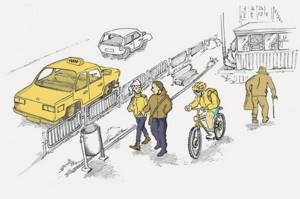
Correct 6. Requirements for cyclists
6.6. A cyclist is prohibited from:
c) move on sidewalks and pedestrian paths (except for children under 7 years old on children's bicycles under the supervision of adults);
Wrong 6. Requirements for cyclists
6.6. A cyclist is prohibited from:
c) move on sidewalks and pedestrian paths (except for children under 7 years old on children's bicycles under the supervision of adults);
8.
Who has the right of way when crossing a bike path?

Correct 6. Requirements for cyclists
6.5. If a bicycle lane crosses a road outside an intersection, cyclists must give way to other vehicles traveling on the road.
Wrong 6. Requirements for cyclists
6.5. If a bicycle lane crosses a road outside an intersection, cyclists must give way to other vehicles traveling on the road.
9.
What distance should be between groups of cyclists moving in a column?

Correct 6. Requirements for cyclists
6.3. Cyclists traveling in groups must ride one after another so as not to interfere with other road users. A column of cyclists moving along the roadway must be divided into groups (up to 10 cyclists in a group) with a movement distance between groups of 80-100 m.
Wrong 6. Requirements for cyclists
6.3. Cyclists traveling in groups must ride one after another so as not to interfere with other road users. A column of cyclists moving along the roadway must be divided into groups (up to 10 cyclists in a group) with a movement distance between groups of 80-100 m.
10.
Does an exercise bike help you not only burn calories, but also lose weight?
In addition to discussing the general attractiveness of an exercise bike, we should also touch on its advantages, which are of interest to a huge number of women, namely, is it possible to lose weight with it? Let’s try to figure it out and highlight the advantages that confirm the attractiveness of the simulator for a female audience who wants to get rid of extra pounds.
- Intensity. The exercise bike provides a fairly intense workout, which is a prerequisite for any cardio exercise. Regular use of the exercise machine several times a week will stabilize blood pressure and, of course, reduce the risk of developing various cardiovascular diseases. Intense training will lower cholesterol levels, which will prevent atherosclerosis and other diseases.
- Active work of muscle groups of the lower body. You will successfully train the muscles of the thighs, lower legs and gluteal muscles. It would not be a shame to show off your toned and slender legs with elastic muscles in a short skirt or bikini. In addition to this, you will get strong buttocks that will drive men crazy.
- Low load on ankles and knees . A sitting position during exercise will reduce the level of stress on the ankles and knees, which will undoubtedly attract ladies suffering from arthritis, as well as those ladies who are just starting active physical training.
- Acceleration of metabolism. Any intense workout can speed up the metabolic process, especially if you do it in the morning before breakfast. The exercise bike is no exception.
According to average calculations, you can get rid of 500 calories per hour on an exercise bike. However, to lose weight, do not forget that you should consume fewer calories than you burn. Due to this, you can really lose weight.
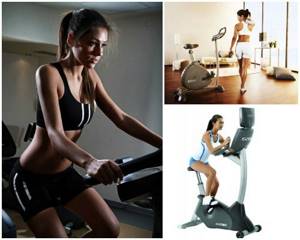
Vehicles will pass through the intersection in the following order

Correct 16. Driving through intersections
16.11. At an intersection of unequal roads, the driver of a vehicle moving on a secondary road must give way to vehicles approaching this intersection of carriageways on the main road, regardless of the direction of their further movement.
16.13. Before turning left and making a U-turn, the driver of a non-rail vehicle must give way to a tram in the same direction, as well as to vehicles moving on an equivalent road in the opposite direction straight or to the right.
Wrong 16. Driving through intersections
16.11. At an intersection of unequal roads, the driver of a vehicle moving on a secondary road must give way to vehicles approaching this intersection of carriageways on the main road, regardless of the direction of their further movement.
16.13. Before turning left and making a U-turn, the driver of a non-rail vehicle must give way to a tram in the same direction, as well as to vehicles moving on an equivalent road in the opposite direction straight or to the right.
11.
Interval exercise for weight loss
Interval exercise is intended for people with good physical fitness. Interval training on an exercise bike involves alternating between fast and moderate speeds. This is a very effective way to lose weight.
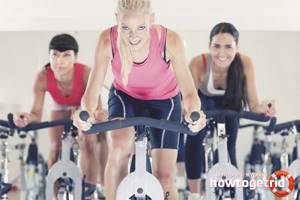
It was previously thought that fat was burned during low-intensity cardio, such as running slowly for a long time. However, modern research has proven that interval training is much more effective - it burns fat for another two days after training. Therefore, today it is considered one of the most effective ways to get rid of excess fat in the body.
Interval exercise on an exercise bike begins with a warm-up - 5 minutes of pedaling at a calm pace. Then you need to alternate between intense and moderate loads in a time ratio of approximately 1:3. The duration is determined only by your physical fitness. For example, in the initial stages, you can pedal for 20 seconds at a fast pace and a minute at a moderate pace. With higher physical fitness, an intense pace can last a minute, and a calm one - 2-3 minutes. After 20-30 minutes of interval training, you need to cool down and finish the workout.
A cyclist passes an intersection:

Correct 8. Traffic regulation
8.3. Traffic controller signals take precedence over traffic light signals and road sign requirements and are mandatory. Traffic lights, other than flashing yellow ones, take precedence over priority road signs. Drivers and pedestrians must comply with the additional requirements of the traffic controller, even if they contradict traffic lights, road signs and markings.
16. Driving through intersections
16.6. When turning left or turning around when the main traffic light is green, the driver of a non-rail vehicle is obliged to give way to a tram in the same direction, as well as to vehicles moving straight in the opposite direction or turning right. Tram drivers should follow this rule among themselves.
Wrong 8. Traffic control
8.3. Traffic controller signals take precedence over traffic light signals and road sign requirements and are mandatory. Traffic lights, other than flashing yellow ones, take precedence over priority road signs. Drivers and pedestrians must comply with the additional requirements of the traffic controller, even if they contradict traffic lights, road signs and markings.
16. Driving through intersections
16.6. When turning left or turning around when the main traffic light is green, the driver of a non-rail vehicle is obliged to give way to a tram in the same direction, as well as to vehicles moving straight in the opposite direction or turning right. Tram drivers should follow this rule among themselves.
12.
Flashing red signals of this traffic light:

Correct 8. Traffic regulation
8.7.6. To regulate traffic at railway crossings, traffic lights with two red signals or one white-lunar and two red ones are used, having the following meanings:
a) flashing red signals prohibit the movement of vehicles through the crossing;
b) a flashing white-lunar signal indicates that the alarm system is working and does not prohibit vehicle movement.
At railway crossings, simultaneously with the prohibitory traffic light signal, an audible signal may be turned on, additionally informing road users that movement through the crossing is prohibited.
Wrong 8. Traffic control
8.7.6. To regulate traffic at railway crossings, traffic lights with two red signals or one white-lunar and two red ones are used, having the following meanings:
a) flashing red signals prohibit the movement of vehicles through the crossing;
b) a flashing white-lunar signal indicates that the alarm system is working and does not prohibit vehicle movement.
At railway crossings, simultaneously with the prohibitory traffic light signal, an audible signal may be turned on, additionally informing road users that movement through the crossing is prohibited.
13.
How many calories should you burn on an exercise bike to lose weight?
The planned calorie consumption on an exercise bike is an individual value. It will depend on the person’s actual weight, as well as the amount of food consumed every day. For those who control their diet and do not go beyond what is permitted, you can exercise on an exercise bike for a short time. Often 30 minutes is enough to lose 200–400 kcal. The frequency of training will also not be strict and everyday.
If the starting weight is significant, and a considerable amount of food is consumed every day, then the training should be tough, and its duration should be longer. Obese people need to exercise every day or every other day, losing 700–1000 kcal from such activities. But they alone will not help if a person consumes several thousand calories every day. You will also have to work on your diet.

The driver of which vehicle will cross the intersection second?

Correct 16. Driving through intersections
16.11. At an intersection of unequal roads, the driver of a vehicle moving on a secondary road must give way to vehicles approaching this intersection of carriageways on the main road, regardless of the direction of their further movement.
16.14. If the main road at an intersection changes direction, drivers of vehicles moving along it must follow the rules for driving through intersections of equivalent roads.
This rule should be followed among themselves and by drivers driving on secondary roads.
Wrong 16. Driving through intersections
16.11. At an intersection of unequal roads, the driver of a vehicle moving on a secondary road must give way to vehicles approaching this intersection of carriageways on the main road, regardless of the direction of their further movement.
16.14. If the main road at an intersection changes direction, drivers of vehicles moving along it must follow the rules for driving through intersections of equivalent roads.
This rule should be followed among themselves and by drivers driving on secondary roads.
14.
Cyclist:
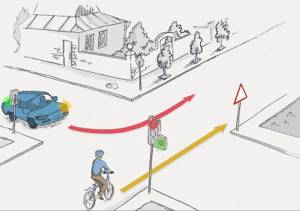
Correct 8. Traffic regulation
8.7.3. Traffic light signals have the following meanings:
A signal in the form of an arrow that allows a left turn also allows a U-turn if it is not prohibited by road signs.
A signal in the form of a green arrow(s) in the additional section(s), switched on together with the green traffic light signal, informs the driver that he has priority in the direction(s) of movement indicated by the arrow(s) over vehicles moving from other directions;
f) a red signal, including a flashing one, or two red flashing signals prohibit movement.
A signal in the form of a green arrow(s) in the additional section(s), together with a yellow or red traffic light signal, informs the driver that movement is permitted in the indicated direction, subject to the unhindered passage of vehicles moving from other directions.
A green arrow on a sign installed at the level of a red traffic light with a vertical arrangement of signals allows movement in the indicated direction when the red traffic light is on from the rightmost lane (or the leftmost lane on one-way roads), subject to the provision of priority in traffic to its other participants moving from other directions to a traffic light signal allowing movement;
16 Driving through intersections
16.9. While driving in the direction of the arrow turned on in the additional section simultaneously with a yellow or red traffic light, the driver must give way to vehicles moving from other directions.
When driving in the direction of the green arrow on the table installed at the level of the red traffic light with vertical signals, the driver must take the extreme right (left) lane and give way to vehicles and pedestrians moving from other directions.
Wrong 8. Traffic control
8.7.3. Traffic light signals have the following meanings:
A signal in the form of an arrow that allows a left turn also allows a U-turn if it is not prohibited by road signs.
A signal in the form of a green arrow(s) in the additional section(s), switched on together with the green traffic light signal, informs the driver that he has priority in the direction(s) of movement indicated by the arrow(s) over vehicles moving from other directions;
f) a red signal, including a flashing one, or two red flashing signals prohibit movement.
A signal in the form of a green arrow(s) in the additional section(s), together with a yellow or red traffic light signal, informs the driver that movement is permitted in the indicated direction, subject to the unhindered passage of vehicles moving from other directions.
A green arrow on a sign installed at the level of a red traffic light with a vertical arrangement of signals allows movement in the indicated direction when the red traffic light is on from the rightmost lane (or the leftmost lane on one-way roads), subject to the provision of priority in traffic to its other participants moving from other directions to a traffic light signal allowing movement;
16 Driving through intersections
16.9. While driving in the direction of the arrow turned on in the additional section simultaneously with a yellow or red traffic light, the driver must give way to vehicles moving from other directions.
When driving in the direction of the green arrow on the table installed at the level of the red traffic light with vertical signals, the driver must take the extreme right (left) lane and give way to vehicles and pedestrians moving from other directions.
15.
Procedure for conducting the training
You need to train regularly in accordance with your schedule. During classes, do not be distracted by extraneous matters, no matter how attractive they may be. The training should be canceled only in cases of malaise and weakness.
To burn calories on an exercise bike, for example, the pedal speed is approximately 40 rpm. In this case, the load level is set to low, and the heart rate is maintained at 75% of the maximum value.
Exercises on an exercise bike, as mentioned earlier, train the heart, lungs, and blood vessels, so they are classified as cardio training. The training schedule for burning calories on an exercise bike and calories on a bike should be drawn up correctly. For unprepared people, it is enough to perform fifteen-minute training sessions with an average load at first. When you get used to this rhythm, move on to classes lasting from 40 to 60 minutes; accordingly, the load needs to be increased and the number of workouts per week should be increased to 3-4 with an interval of a day or more, so that the body has the opportunity to recover.
To lose weight, a low-calorie diet is added to workouts that burn calories on an exercise bike and calories on a bicycle. If you follow the recommendations, the result will be inspiring.
In order to get less tired and not get bored during classes, you should alternate the training system: calm pedaling should be followed by intense movements. The choice of program is at the discretion of the trainee. You can choose to simulate driving on a horizontal surface or with uphill climbs. During training, heart rate monitoring is mandatory. It’s easy to find detailed calculations on the Internet, but on average the heart rate lies in the range of 65-80% of the maximum value. A device that shows your heart rate - a heart rate monitor - helps you monitor the number of calories burned on an exercise bike and calories on a bike.
The advantage of an exercise bike over the fairly popular treadmill is that it reduces the load on the joints and spine, which is present in overweight people.
Can a cyclist turn left?

Correct 11. Location of vehicles on the road
11.14. Movement on the roadway on bicycles, mopeds, horse-drawn carriages (sleighs) and horseback riders is permitted only in one row in the rightmost lane as far to the right as possible, except for cases when a detour is in progress. Left turns and U-turns are permitted on roads with one lane in each direction and no tram tracks in the middle. Driving on the side of the road is permitted if this does not create obstacles for pedestrians.
Wrong 11. Location of vehicles on the road
11.14. Movement on the roadway on bicycles, mopeds, horse-drawn carriages (sleighs) and horseback riders is permitted only in one row in the rightmost lane as far to the right as possible, except for cases when a detour is in progress. Left turns and U-turns are permitted on roads with one lane in each direction and no tram tracks in the middle. Driving on the side of the road is permitted if this does not create obstacles for pedestrians.
How to exercise correctly to lose calories on an exercise bike?
When deciding how many calories you can burn on an exercise bike, as well as how much you will need to spend, you should not forget about the main rules for performing such physical activity. You should not violate them, so as not to get the opposite effect - harm to health.
Burning calories on an exercise bike should be carried out according to the following rules:
- Only after examination by a doctor and obtaining the appropriate permission. There is no point in prescribing intensive exercises for yourself.
- For a minimum of 30–40 minutes, so that the metabolic process is started. The intensity will depend on desire and physical capabilities.
- It is important to adhere to the previously stated formula. The pulse rate often determines a person’s capabilities, as well as the level of load.
- It is better to conduct training under the guidance of an experienced trainer, who will determine the level of training and the real need for the amount of training. For beginners, only 203 sessions will be required, which can be increased over time. But people with an average level of training can be prescribed training more often - 4 times a week.
- It is necessary to monitor your breathing. An intensive supply of oxygen allows for a normal metabolic process. Oxygen is involved in the process of fat breakdown.
- Monitor the amount of incoming water. The minimum you need to consume is 2–2.5 liters of fluid per day. During training, which involves increased sweating, it is important to drink a lot so as not to disturb the water-salt balance.
- Proper nutrition - don’t think that even the most exhausting workouts can work a miracle if you don’t reconsider your diet.

